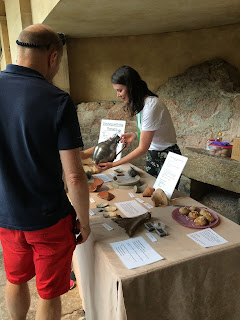“Food is our common ground, a universal experience”
James
Beard
Food is part of our everyday life, sometimes we even plan
our days around food, eating it or cooking it! It’s not a surprise that the
Romans did too.
My own love of food and cooking was the inspiration for my
handling table. I wanted to learn about Roman cooking tools and methods, maybe
even try a bit of cooking myself. When I began looking at the objects within the museum’s
collection, I was stunned to find that much of the methods and utensils of
cooking weren’t too dissimilar to those used today.
 |
| Getting up close and personal with the collection, visitors are encouraged to hold objects |
The Romans increased the availability and variety of food in
Britain, introducing new and exotic ingredients, especially for the wealthier
classes. Food scraps found by archaeologists today, such as bones and shells, are evidence of food
eaten by the Romans. Fish varieties were eaten widely and used to make garum, a
fermented fish sauce used as a salty seasoning in cooking.
Butchery marks on animal bone tell us that people were
eating and probably selling meat. The scratches and cuts in the bone require a
closer look. A bone will splinter or shatter if broken; we know these marks are
butchers marks because of the clean cuts into the bone, which can only be caused
by a sharp blade.
 |
| Handling animal bone with obvious signs of butchery |
Pottery was used throughout the kitchen for cooking, storage
and serving. Large ceramic pots were used to cook stews and soups and could
also be used to store food. Lighter, smaller cooking vessels, such as pewter or
bronze pans were popular with soldiers but could also be used in the home.
 |
| Bronze patera found during excavations of the Sacred Spring, on display at the Roman Baths |
My favourite object was the mortarium, a bowl-shaped vessel with grit embedded surface used as
a grinding and mixing bowl. This ancient mortar and pestle was one of the most
important tools in the Roman kitchen. The Romans liked food that was heavily
spiced, possibly to hide the taste of old meat, and needed a tool to grind all
these spices to a useable powder or paste.
 |
| Left: North Gaulish mortarium rim, Right: close up of maker's stamp |
This particular mortarium
is special because of the maker’s stamp near the spout (see image above). This stamp belongs to Quintus Valerius Veranius, with a date
range of 65-100 A.D. His stamps have been found on mortaria in Northern France, western Belgium and Britain. This
helps us trace the movement of the maker and their wares from workshop to
country, which in turn helps us create a bigger picture of Roman life in
Britain.
Imogen Westcott
Collections Placement
Thanks for this post Imogen. Very interesting and relevant, especially in Bath today!
ReplyDelete